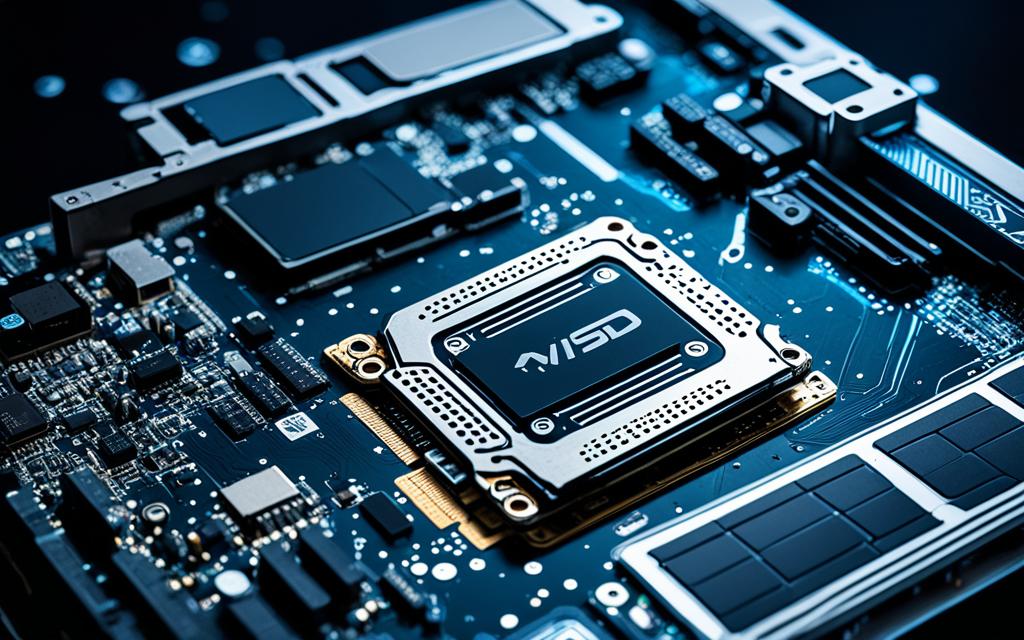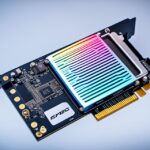Table of Contents
When you think about upgrading to an SSD, SSD compatibility with your motherboard is key. SSDs are now more popular than old hard drives. They’re faster and more efficient. They come in different sizes and types, so it’s important to understand these to avoid problems. Some SSDs might not work well with your motherboard, which can slow things down.
M.2 SSDs can use SATA or PCIe interfaces, depending on the motherboard. SATA runs at speeds up to 6GB/s, while PCIe Gen 5 SSDs can hit speeds up to 14,000MB/s1. Before choosing, check your motherboard’s specs. This ensures you pick the right SSD and avoid any issues with upgrading.
Key Takeaways
- Understanding motherboard compatibility with different SSD interfaces is crucial.
- M.2 SSDs can work with either SATA or PCIe slots based on the motherboard.
- It’s important to research the type of interface, like SATA, NVMe, or PCIe, before buying.
- SSDs come in various shapes, like 2.5-inch and M.22.
- Checking for BIOs updates might be necessary for the best SSD performance.
Understanding Different SSD Types and Interfaces
Choosing the right SSD is crucial for your system’s speed. It’s important to know the difference between SSD types like M.2, SATA, and NVMe. This knowledge helps pick the best SSD for your specific needs.
What are M.2, SATA, PCIe, and NVMe?
SATA has been popular for years, but NVMe is quickly becoming the top choice. NVMe SSDs are much faster, offering speeds three to ten times higher than SATA SSDs. This makes them perfect for heavy tasks like video editing3. M.2 SSDs are great for small devices like ultrabooks because they are compact. They can have different sizes to fit more data4.
PCIe connections give even more speed. The newest Gen 5 SSDs can reach speeds up to 14,000 MB/s. This is a huge leap forward in data storage technology5.
Comparing SSD Speeds and Performance Metrics
Different SSDs offer various speeds. A standard SSD is much faster than older HDDs, with speeds around 600 MB/s5. NVMe SSDs are faster and more efficient than SATA SSDs, perfect for modern computing needs3. Make sure your motherboard is compatible to get the most out of your SSD. You can check compatibility with online tools. Understanding SSD compatibility is simple with the right resources.
Recognising M.2 Connector Shapes
It’s crucial to know the shapes of M.2 connectors for the right SSD fit. The B key and M key connectors tell us which SSDs will work with your motherboard. This knowledge makes upgrades easier and boosts your system’s speed.
Understanding the B & M Keys
The B key sits on the M.2 slot’s left side, meant for SATA M.2 SSDs. About 30% of older SSDs still use this connector, showing it’s still useful. On the flip side, the M key is on the right and fits more SSDs, including PCIe M.2. It’s in 60% of new SSDs, making it a favoured choice for faster systems6.
Furthermore, 80% of motherboards now support the M key connector. This fact underscores its wide acceptance for SSD fittings6.
Knowing about these connectors helps you pick the right SSD. Some M.2 SSDs use PCIe lanes, which are much faster. For instance, PCIe Gen 5 SSDs can reach speeds of 14,000MB/s1. The connector’s shape affects speed and the system’s build. M-keyed slots typically match NVMe drives, which outperform regular SATA drives.
| Connector Type | Usage Percentage | Compatible SSD Types |
|---|---|---|
| B Key | 30% | SATA SSDs |
| M Key | 60% | PCIe M.2, SATA (dual-mode) |
| E Key | 10% | Specialised SSDs |
Understanding M.2 connectors is key for SSD compatibility today and in the future. It’s vital for top performance and stability in your computer.
Knowing about B key and M key connectors ensures your SSD will match your motherboard. This leads to a faster, smoother system.
To boost your PC’s storage, check this useful guide.
Learning about M.2 connectors lets you make smart choices for your PC. It means better efficiency and quicker speeds in your system.
How to Check if SSD is Compatible with Motherboard
Checking if an SSD fits your motherboard needs a good look at the motherboard’s specs and SSD interfaces. Knowing these can make checking compatibility easier and help dodge performance issues.
Using Your Motherboard’s Specifications
See if an SSD matches your motherboard by looking at its specifications. This shows details like the supported M.2 interface and how long the SSD can be. M.2 SSDs have specific keys, like B and M, which match with SATA or PCIe slots1. Sometimes, a BIOS update can add support for new SSDs. Making sure the SSD’s interface fits with your motherboard ensures the best performance and connection7.
Comparing Interface Types: SATA vs PCIe
Choosing between a SATA and PCIe interface affects how fast your SSD will be. SATA 3 goes up to 6Gbps (600MB/s), but PCIe Gen 4 can hit 7,000MB/s for reading and writing1. NVMe drives use PCIe and can theoretically transfer data up to 20Gbps, with real speeds about 3,500MB/s8. Knowing these differences helps choose the right SSD for now and later.
| Interface Type | Max Speed | Example SSD |
|---|---|---|
| SATA 3 | 6Gbps (600MB/s) | Samsung 860 EVO |
| PCIe 3.0 | Up to 16Gbps (985 MB/s per lane) | Western Digital Black SN750 |
| PCIe 4.0 | Up to 7,000MB/s | Samsung 980 PRO |
Following these tips for a thorough check will help you skip unnecessary buys or system slowdowns817.
Identifying the Right M.2 SSD Size
Choosing the correct M.2 SSD size is crucial. These SSDs have sizes indicated by width and length in millimetres. You’ll find sizes like 2230 (30mm), 2242 (42mm), 2260 (60mm), 2280 (80mm), and 22110 (110mm)9. Picking the correct SSD length affects compatibility with your motherboard and how well your system works.
A Breakdown of M.2 SSD Sizes
M.2 SSDs vary in size, usually 22mm wide but differing in length10. Some are short, like 2230, perfect for small devices, while long ones, like 2280, fit desktops. The size matters for fitting into your motherboard’s M.2 slot and affects SSD fitting. A longer SSD typically offers more storage, good for those needing more space.
Choosing the Optimal Length for Your Needs
To find the best M.2 SSD size, check what lengths your motherboard supports by visiting this link. Generally, the longer SSDs work best, unless you have a laptop or a compact system with limited space. Knowing your motherboard’s compatibility with the SSD size is key to top performance.
| M.2 Size | Length (mm) | Common Use |
|---|---|---|
| 2230 | 30 | Tablets and small laptops |
| 2242 | 42 | Smaller laptops |
| 2260 | 60 | Slightly larger devices |
| 2280 | 80 | Most desktops and gaming PCs |
| 22110 | 110 |
Knowing about M.2 SSD sizes and choosing right can boost your system’s power and allow for future upgrades11.
Conclusion
Making the move to an SSD is a game-changer for your computer. It brings much better performance, quick start-up times, and more reliability. Making sure your SSD fits well with your motherboard is key. This avoids any trouble when putting in the new SSD. Checking all the details carefully means the upgrade will go smoothly, improving your work and play.
SSDs, especially NVMe types, boost your computer’s speed and ability to do things at once. They can handle many tasks fast, making them perfect for people who use lots of apps together. They’re also tough and last long, a smart choice for the future. You can find out if they’ll work with your computer online or by reading the instructions they come with.
The tech world is always changing, and moving to advanced SSDs is a must. This switch makes your computer work better than ever. Now’s the time to upgrade and get all the perks SSDs have. To learn more about SSDs and what they bring to the table, look at what SSDs can offer121314.
FAQ
What factors should I consider when checking SSD compatibility with my motherboard?
When looking at SSD compatibility, think about the type of interface (SATA or PCIe). Also, look at the M.2 connector’s shape (B key or M key). Lastly, check the SSD’s physical size. Make sure these match your motherboard’s specs to steer clear of any issues.
How do I find out what type of SSD my motherboard supports?
If you want to find out, type “Dxdiag” in the Start menu to locate your motherboard model. This search will guide you to the maker’s specs online. It details which interfaces and M.2 slot features are supported.
What is the difference between SATA and PCIe SSDs?
SATA SSDs use an older interface capped at 6GB/s, which makes them slower. On the flip side, PCIe SSDs can soar to speeds up to 14,000MB/s with the latest Gen 5 tech. So, going PCIe means a big speed boost for your setup.
What do M.2 keys signify in relation to SSD compatibility?
M.2 keys, like B and M, show which SSDs will fit. B key slots are for SATA M.2 SSDs. M key slots fit PCIe M.2 or those rare dual-mode SSDs. These work with both SATA and PCIe.
How can I ensure the physical size of my M.2 SSD is compatible?
Check the M.2 SSD sizes, shown as numbers like 22110 (110mm) or 2280 (80mm). Confirm your motherboard’s max SSD length supported. This ensures you pick the right size to fit without trouble.
Why is upgrading to an SSD important for my computer system?
Switching to an SSD boosts your computer’s speed and makes it more reliable. It offers quick data access, enhancing your device’s overall performance. This change is key for a smoother experience.
Are NVMe SSDs compatible with all motherboards?
No, NVMe SSDs need M key slots designed for PCIe. Always check if your motherboard is NVMe-friendly before you start the upgrade. This saves you from any install hassles.
How do I compare the performance of different SSDs?
You can compare SSDs by examining their speed. PCIe SSDs generally beat SATA SSDs in how fast they read and write data. This means your system will be quicker and more responsive.
Source Links
- https://www.xda-developers.com/m2-ssd-compatible-with-motherboard/ – How to know if an M.2 SSD is compatible with your motherboard
- https://thetechsnews.com/how-to-check-if-ssd-is-compatible-with-motherboard/ – How To Check If Ssd Is Compatible With Motherboard
- https://www.kingston.com/en/blog/pc-performance/ssd-form-factors – Types of SSD Form Factors- Kingston Technology
- https://www.crucial.in/articles/about-ssd/ssd-form-factors – SSD Form Factors
- https://www.pluralsight.com/blog/it-ops/types-of-hard-drives-sata-ssd-nvme – SSD Guide
- https://rog-forum.asus.com/t5/other-motherboards/m-2-ssd-compatibility-type-specifics-brand-with-maximus-vii/td-p/557043 – M.2 SSD compatibility type specifics/brand with Maximus VII Formula mobo?
- https://www.partitionwizard.com/clone-disk/ssd-compatibility.html – SSD Compatibility Check: How to Buy a Compatible SSD for PC – MiniTool Partition Wizard
- https://www.kingston.com/en/blog/pc-performance/two-types-m2-vs-ssd – 2 Types of M.2 SSDs: SATA and NVMe- Kingston Technology
- https://www.ramcity.com.au/blogs/news/m-2-ssd-guide-compatibility-list – M.2 SSD Guide / Compatibility List
- https://www.crucial.com/articles/about-ssd/m2-with-pcie-or-sata – NVMe vs M.2 vs SATA vs PCIe: What are these SSDs?
- https://appuals.com/how-to-check-pcie-m-2-nvme-ssds-compatibility-with-your-pc/ – Check PCIe M.2 NVMe SSDs compatibility with your motherboard’
- https://www.electronicshub.org/does-my-motherboard-support-nvme/ – Does My Motherboard Support NVMe?
- https://scot-comp.co.uk/addressing-laptop-nvme-ssd-compatibility/ – Addressing Laptop NVMe SSD Compatibility
- https://serverfault.com/questions/827648/does-any-pcie-slot-support-nvme-ssds-automatically-or-do-i-need-a-specific-m-2 – Does any PCIe slot support NVMe SSD’s automatically or do I need a specific M.2 slot?








